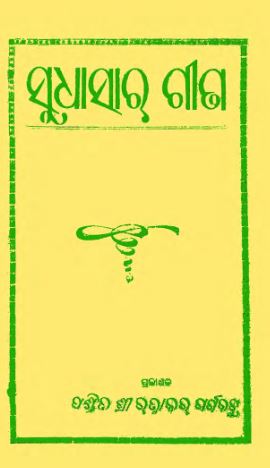Published in 1939, “Sudhasar Gita” by Chandramani Das stands as a significant landmark in Odia literature, merging the realms of poetry and philosophy. This illustrious work encapsulates the essence of human emotion, spirituality, and the nuances of everyday life, captivating readers with its profound insights and lyrical beauty.
Chandramani Das, a prolific poet of his time, drew inspiration from the rich cultural heritage of Odisha while infusing contemporary themes into his poetry. “Sudhasar Gita” is not just a mere collection of verses; it is an intricate tapestry woven with the threads of philosophical contemplation and poetic expression. The title itself, translating to “The Nectarous Song,” hints at the sweetness of wisdom and the richness of life experiences that the poet seeks to convey.
The book transcends the traditional boundaries of poetry, delving into existential inquiries and the search for meaning. Das employs a conversational tone, inviting readers to engage in a dialogue with their inner selves. In doing so, he explores essential themes such as love, nature, the divine, and the human condition—subjects that resonate across cultures and time periods.
One of the hallmark features of “Sudhasar Gita” is its exquisite use of imagery and metaphor. Das paints vivid pictures of the natural world, drawing parallels between the beauty of the environment and the intricacies of the human spirit. His verses evoke the sights, sounds, and smells of Odisha, grounding his philosophical musings in a tangible reality. Through descriptions of lush landscapes, blooming flowers, and the rhythmic flow of rivers, the poet invites readers to appreciate the interconnectedness of all living beings.
Philosophically, “Sudhasar Gita” reflects a deep understanding of life’s transitory nature. Das grapples with themes of impermanence and the inevitability of change, nudging readers to embrace the present moment while contemplating their place in the grand tapestry of existence. His reflections echo the sentiments of various philosophical traditions, suggesting a universal quest for understanding and transcendence.
Additionally, Chandramani Das incorporates elements of Odia folklore and mythology into his poetry, enriching his work with cultural depth. By intertwining traditional narratives with modern existential questions, he creates a dialogue between the past and the present, illuminating the timeless nature of his themes.
The language of “Sudhasar Gita” is another testament to Das’s poetic prowess. His choice of words and rhythmic patterns creates a melodious quality that enchants readers. The lyrical nature of his writing allows for multiple interpretations, enabling readers to draw their own meanings and insights. This multifaceted approach ensures that the poetry remains relevant, inviting new generations to engage with the text and derive personal significance from it.
In conclusion, “Sudhasar Gita” by Chandramani Das is a poignant exploration of life, bridging the realms of poetry and philosophy. Through beautifully crafted verses, the poet invites us on a journey of introspection and understanding, urging us to seek the nectarous essence of existence. As we turn the pages of this remarkable work, we are reminded of the enduring power of poetry to illuminate our hearts and minds, transcending the barriers of time and place. This book not only enriches Odia literature but also adds to the broader tapestry of Indian poetry, where the quest for truth and beauty continues to resonate.
Books Info
| Books name | Sudhasar Gita/ସୁଧାସାର ଗୀତା |
| Author | Chandramani Das |
| No Of pages | 143 |
| Publisher | NA |
| Publication | 1939, 5e. |
| Printed At | NA |
| Distributor | NA |

